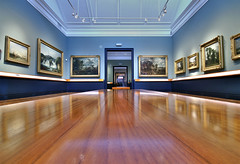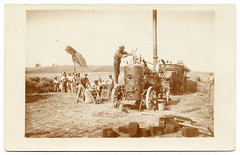* where are we now? ; * what's wrong with where we are now? * what can we do about it? * do we need a new vision?Two years on, and with the digital doors of the OpenFields library open, I find myself asking these new questions:
What can we learn about the future sustainability of digital repositories from the models evolved by physical repositories?
Are there some potential digital exemplars to monitor?
 How about the word "repository"? It seems ironic that our nearby real repository, Blowers Repository, in Shrewsbury, is located somewhere between the library and the museum. Indeed, it's an archive. It's not a library, and it's not a museum, but it shares some of the attributes of both.
How about the word "repository"? It seems ironic that our nearby real repository, Blowers Repository, in Shrewsbury, is located somewhere between the library and the museum. Indeed, it's an archive. It's not a library, and it's not a museum, but it shares some of the attributes of both. Maybe the word "repository" does itself no favours. We think of a repository being somewhere you stash stuff away very safely... for preservation... so you know exactly where it is... but don't need to visit it too often...
Maybe it's no surprise about what the word "repository" rhymes with? A place where the sun don't shine.
So, why might anyone bother to visit a repository?  Well, recently, the Victoria & Albert Museum asked itself just that, and in the interests of 'widening participation' came up with this ingenious slogan:
Well, recently, the Victoria & Albert Museum asked itself just that, and in the interests of 'widening participation' came up with this ingenious slogan:
 Well, recently, the Victoria & Albert Museum asked itself just that, and in the interests of 'widening participation' came up with this ingenious slogan:
Well, recently, the Victoria & Albert Museum asked itself just that, and in the interests of 'widening participation' came up with this ingenious slogan:I'm sure the V&A has lost none of its gravitas - it took a risk and gained some street cred.
A while back, thanks to some NOF funding, Blowers Repository had a bit of a digital airing -and you can now see some of its content through the Secret Shropshire website. This is one of the Digital Midlands 'Sense of Place' projects. Take a look. I think you'll find that they are really all repositories... but they don't feel like repositories....
Cast an eye through the rationale behind Digital Ladywood for example, and you'll see there's a strong sense that this is actually more about community and communication than about preservation. Ladywood is a notably deprived area of Birmingham - sporting this active community-focused resource - no elitist showcase here! And they aren't alone. Take a journey through the rich diversity that is there for all to see in NewhamStory.com, and it's soon clear that these are something more than just archives gathering digital dust. They are living social spaces...
 When Mrs Pitt-Rivers told Augustus Henry Lane Fox Pitt-Rivers that his shed simply wasn't big enough for all his accumulated stuff, I wonder if she knew what an eclectic resource this was to become? Who is it aimed at? Researchers? Historians? Tourists? Children? Well... its audience must be as wide as its collections are eclectic.
When Mrs Pitt-Rivers told Augustus Henry Lane Fox Pitt-Rivers that his shed simply wasn't big enough for all his accumulated stuff, I wonder if she knew what an eclectic resource this was to become? Who is it aimed at? Researchers? Historians? Tourists? Children? Well... its audience must be as wide as its collections are eclectic. We seem to have had a habit in the academic repository world of being driven by supply. If we happen to have 13,000 images of farmers and stockbreeders from 1920 to 1965 in a digital box under our virtual bed, we're pleased to make that visible... and laudable it is, too.
We seem to have had a habit in the academic repository world of being driven by supply. If we happen to have 13,000 images of farmers and stockbreeders from 1920 to 1965 in a digital box under our virtual bed, we're pleased to make that visible... and laudable it is, too. Is this what's actually in demand? If our repositories are spaces for our communities, how much are our doors open to community contribution? Who, in fact, are the experts?
In OpenFields, we've taken the apparently uncommon step of combining 'three libraries in one'... "Technical and Business Information" is pragmatic, practitioner-focussed material that's straightforward to digest and has a clear commercial relevance. "Research Papers and Abstracts" are the peer-reviewed outcomes of academic research projects - (and academics do have a habit of writing mostly for other fellow academics.) "Open Learning Materials" are more about guiding the learner to grasp techniques, skills and concepts. Each are constructed in rather different styles, and therefore catalogued in rather different ways. Yet it's entirely possible that a user browsing the OpenFields collections may be open to  exploring more than one type of knowledge asset.
exploring more than one type of knowledge asset.
 exploring more than one type of knowledge asset.
exploring more than one type of knowledge asset.Maybe academia need not just be a provider of knowledge, but can also be a facilitator of knowledge... sourced from a wide community of experts? OpenFields is arguably, therefore, a foundation for communities of practice.
This isn't about preservation and posterity - it's about community and continuity. And maybe we can all be experts in some way?
Full presentation available at http://ofi.openfields.org.uk/1.10040556
1 comments:
I have to admit to being torn about this.
With my IT hat on, repositories can't be closed archives, ghettoised away from the Open Web and its creativity. They have to be places where users interact with resources, interrogate them, enhance them. Users brought up in Web 2.0 don't want to distinguish between YouTube and Repositories, and are scandalised that there aren't comment fields and retweet buttons in repositories. I'm finding myself feeling the same way about academic databases now. We've argued along those lines in a position paper for the ADL workshop, which preceded your CETIS workshop.
As a would-be academic in the humanities, OTOH, archiving matters to me. And from my irascible perch, it no longer looks like mattering to institutional libraries, who prioritise having nice cafés for students and their laptops over book space. That has ended up meaning that all the books I used for my PhD are being sent to stacks, and will never be browsed again. (Well, that, and the fact that my subject area is no longer taught in that university.) My visceral reaction is, if you do that to my books, you are the enemy.
(The books aren't being pulped, true: they are in fact being... archived. But they are no longer readily accessible, which does make a difference.)
It's not a fair reaction, I admit. But it's not what you're saying. Putting the images of the stockbreeders online is not just laudable (a term still a little close to damning with faint praise); it is Right. Digital libraries should be making that stuff more accessible and more engageable with: they should allow communities to form around those resources, if there is demand for it.
And if there isn't? (Which is why I reacted.) Leave it online for the Long Tail, and allow the community to form when it might. Being an archive where the sun don't shine isn't sexy, and isn't a priority for funding. But it is still part of a repository's mission.
Post a Comment